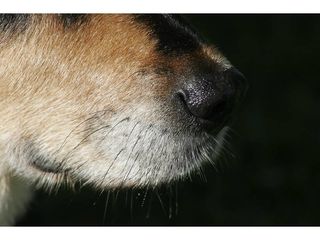
Like cats dogs will often reflexively flare their whiskers and then point them in a forward direction when they feel threatened which some scientists believe indicates that whiskers play a role in the defense strategy during combative. A dog may have white whiskers or they may turn white due to exposure to sunlight effects of lupus lack of melanocytes cells that produce melanin ageing effects genetic factors liver disease vitiligo circumstances stress anxiety and health issues like Hypothyroidism kidney disease.

A dog may have white whiskers or they may turn white due to exposure to sunlight effects of lupus lack of melanocytes cells that produce melanin ageing effects genetic factors liver disease vitiligo circumstances stress anxiety and health issues like Hypothyroidism kidney disease.
Why do dogs get white whiskers. Why Do Dogs Have Whiskers. Dogs have a set of stiff hairs protruding from the sides of their muzzles that are popularly called whiskers. These are not at all like the nonfunctional whiskers.
A dogs hair turns white when his body stops forming melanin. Just as it is with humans aging is the most common cause of white hair in dogs. It is a normal and natural process and is not a cause for concern.
Whiskers help dogs see things that lie right under their noses by constantly sending information to the canine brain. As a dog approaches something in his path he stirs up air currents that bounce back when they hit solid objects. Like cats dogs will often reflexively flare their whiskers and then point them in a forward direction when they feel threatened which some scientists believe indicates that whiskers play a role in the defense strategy during combative.
Basically when anything in your dogs environment happens to rub against your dogs whiskers the whiskers vibrate stimulating special nerves found in the hair follicles which in turn provide feedback about the surrounding environment explains veterinarian Dr. For a good reason the word vibrissae comes from the ancient Latin word vibrio which means to vibrate. A dog may have white whiskers or they may turn white due to exposure to sunlight effects of lupus lack of melanocytes cells that produce melanin ageing effects genetic factors liver disease vitiligo circumstances stress anxiety and health issues like Hypothyroidism kidney disease.
Whiskers are exceptionally advantageous for dogs as they guide them to get through their little world. There is no denying the fact that whiskers also enhance the appeal of the dog making them look more adorable. Being brilliant hairy sensors whiskers assist the dogs in.
A dogs vibrissae receives outside stimulus which is sent to the follicle from which it is then transmitted to a dogs brain allowing it to decode this signal and generate a response. Thanks to this mechanism a dogs whiskers and vibrissae fulfill several functions. Like all hair follicles chin whiskers are subject to disease.
Pyoderma is one such disorder where a bacterial skin infection causes cuts filled with pus. Demodex mites can burrow into the hair follicle causing pus-filled sacs and loss of whiskers in a disease called demodectic mange. A dogs hair turns white when his body stops forming melanin.
Melanin is the pigment that colors hair and without it hair is white. Just as it is with humans aging is the most common cause of white hair in dogs. It is a normal and natural process and is not a cause for concern.
Whiskers are key to helping dogs perceive their surroundings in ways that are more nuanced than what they can see with their vision only. Ever throw a treat that lands right in front of your dogs face but they somehow cant seem to find it. The Whiskers Are Vibrissae.
Whiskers are hairs but not the same as the hairs in your dog or cats coat. These stiffer thicker hairs are called vibrissae and their follicles are embedded deeper in the skin than coat hairs. Although the whiskers are different from the hair coat they are shed as the hair coat is and will grow back.
Your dogs whiskers allow them to feel things that are nearby which provides them with useful information. They are able to tell the size speed and shape of things that are close to them which aids in avoiding potent danger. Dogs also use their whiskers when experiencing certain emotions.
While there are probably many more subtle uses of whiskers to that effect which we have yet to identify a clear one happens when the dog feels like something is threatening it. The whiskers of a threatened dog reflexively spring into action flaring and pointing forward. Whiskers are also used when dogs express their emotions.
When a dog is scared or feeling threatened they will point their whiskers forward seemingly a defense strategy. When a dog is asleep so are its whiskers but when a dog is active the whiskers are too. The technical name for the the stiff and heavy hairs that grow out from your dogs muzzle and over your dogs eyes is vibrissae However you know them as whiskers They are more obvious on dogs that have short hair on their faces but may be hidden on dogs with mustaches and beetling eyebrows like many terriers have.
Formally known as vibrissae canine whiskers are plugged into a dogs nervous system and act as sensory receptors to aid a dogs vision. Other than trimming them for showing theres no reason to ever cut your dogs whiskers. The scientific term for whiskers is vibrissa and they help dogs feel and explore their surroundings.
These special tactile hairs are an evolutive trait that allows mammals to determine the size of nearby objects detect threats find their food and much more.